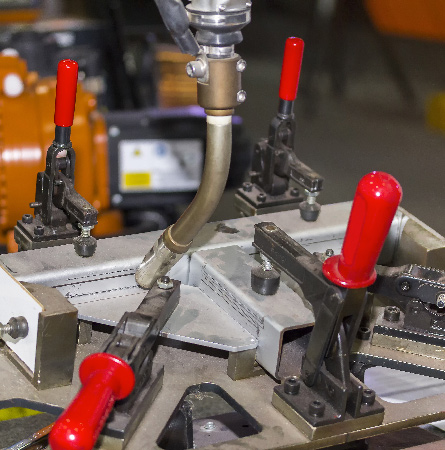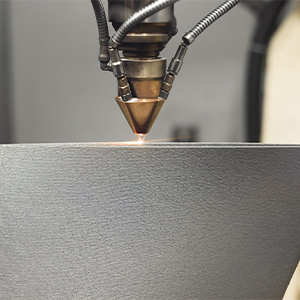How to Choose Holding/Toggle Clamps
Post By: Julian Oakes On: 20-11-2020 - Manufacturing
A holding or toggle clamp is one of the most useful tools you can have in any workshop, giving you control over the workpiece. Its function is simple, to hold things in place while you perform some other action on them. Whether you're a small-scale cabinet maker or an industrial machine shop, you always need to hold your pieces securely in place.
Knowing how to choose holding/toggle clamps requires an assessment of what function you are performing, with what materials, and for how long. They should provide maximum efficiency and safety. There are many manufacturers of holding/toggle clamps, which makes it easier to pin down exactly the right type for your needs. Destaco, for example, is one of our family of approved suppliers at Rowse. This company filed the first toggle clamp patent in 1936, and they know everything there is to know about work holding.
What Is A Holding/Toggle Clamp?
A holding or toggle clamp is a piece of equipment used most commonly for holding things together, or holding them stationary by applying fixed pressure. It's a very versatile piece of equipment, whether it be the widely used manual type or a powered version for heavier work. In an industrial setting you can install a powered clamping system, either pneumatic or hydraulic. Power clamps can develop a greater amount of pressure. They are typically deployed in automated manufacturing processes, because they can clamp components quickly, repeatedly and accurately. They can also be quickly activated and deactivated, and apply uniform pressure. This means fewer process errors and part deformities. Manual clamps, however, are portable, come in a wide range of sizes and styles, and can fit into all kinds of spaces.
How Does A Holding/Toggle Clamp Work?
The toggle clamp is generally attached to a fixed point, such as a table or jig. Moveable objects can then be placed under the clamp and held securely in position. They comprise a mounting shaft with a pivot pin and flanges where the clamp can be attached to its mounting. A fixed-length lever pivots around the pin in a central mounting, and its action forces the clamping arm open or closed. An adjustable vertical screw is usually mounted on this arm, with a foot made of rubber or some non-impacting gripping material which connects with the workpiece, although often these are modified for bespoke applications. Pressure can be varied, and some types of clamp offer flexibility of adjustment for different workpiece thicknesses. The lever also has a lock point over the central axis which provides a fixed stop and linkage, so that the clamp can't unlock unless this linkage is moved.
Toggle clamps are rated as to their holding capacity, which denotes the maximum force or load they can sustain in the locked position (usually denoted as pounds of force, or lbf). Many machine shops and manufacturers keep a variety of clamps in different sizes so that they can accommodate a wide range of materials and holding power.

How To Choose A Holding/Toggle Clamp
Knowing how to choose the right holding/toggle clamps will depend on a number of factors, including what holding capacity you require and how much force you'll need to exert to achieve that. The essential requirement of a holding/toggle clamp is to hold a workpiece in a specific position for the shortest possible period of time. To do this you'll need to use a specific amount of force, which will hold the workpiece securely without distorting or damaging it during the clamping operation.
Other things to take into account when deciding how to choose holding/toggle clamps are what shape and size parts you need to hold, and whether they're uniform or variable. In addition, you must decide whether the clamp is for temporary or permanent use, and whether the environment designated for its use will affect the materials or operation of the clamp. Clamps for use in hazardous environments, for example, will require greater durability of materials.
You must also factor in how long the holding operation is expected to take, as it makes a difference whether you want to hold something for five seconds or five hours. The operation may also be part of a cycle of sequenced production processes, so it must be capable of repeated and accurate performance. High clamping forces must be maintained while still providing good accessibility to the workpiece.
There are safety factors to consider so as to prevent injury to the operator. You must consider the strength and dexterity of the clamp's operator and the position they must maintain to operate it. This means that the clamp should be mounted where it's comfortably accessible, and doesn't put strain on any part of the body during its operation. Ergonomically styled handgrips also make the operation more comfortable. To prevent any unintentional opening of the clamp, many companies such as Destaco offer models with a secondary lock as an additional safety feature. This helps to maintain the over-centre fixed locking and provides additional protection against accidental opening.
Once you have a basic idea of these factors, you can then move on to choosing the most appropriate clamp, to include the following options:
Type
As well as distinguishing between manual and power clamps, there are other factors to consider. These are usually determined by the space in which the clamp is to be situated and how much manoeuvrability it allows. Levers for manual toggle clamps can be horizontal or vertical, operate with a push or pull linear action, use a rolling cam instead of a pivot, or have a hook instead of a clamping foot. Other types of holding clamp include squeeze-action clamps which work like grippers, and latch clamps. Latch clamps work by placing a hook at the end of the clamping arm around an opposing latch, and pressing the handle down to lock it into position. This type of clamp is seen on old-fashioned Kilner jars and swing-top bottles, and is commonly used for sealing covers, lids and doors.
Horizontal Or Vertical
The horizontal lever holding/toggle clamp is probably the most commonly used, particularly when the machinery has height limitations. It's simple, portable and available in a wide variety of sizes and tolerances. When the handle is up, it's open, and you can place your material under the foot. When the lever is pulled down into the horizontal position, parallel with the base, the clamping arm lowers the foot into position. The final push down of the lever brings it to the locking point, where it cannot be accidentally opened and the material will be held firm. The vertical holding/toggle clamp works on the same principles, except in reverse: the clamp is locked when the lever is up, perpendicular to the base, and open when it's horizontal.
This basic lever and fulcrum principle is applied also to push-pull or straight-line clamps, which use the force of the lever to operate the clamp in a horizontal linear motion. In these models, the push/pull handle moves the clamp's plunger back and forth along its axis. Many clamps of this type can be used for both pushing and pulling operations, as they can be locked in two alternative positions.
Size And Shape Of Workpiece
What type of clamp you choose will depend on the size of your workpiece and whether it's a regular or irregular shape. If you're mass-producing one item of a uniform shape and thickness, then you select the clamp that best fits that profile. If you want something a bit more versatile, for varying thicknesses that may not be of a uniform shape, then you can choose a self-adjusting clamp that will allow for these factors.
Force
The amount of force required for your operation will also affect how you choose your holding/toggle clamps. This is determined by the materials you are using and their surface finish. It's also influenced by the machining process as a whole, for tasks such as drilling, milling, bonding, welding, sealing or joining.
As far as manual clamps are concerned, there are several variables that contribute to the actual force applied to the holding operation. These include how much force is exerted by the operator on the handle, and where specifically on the handle it is applied. There are also mechanical considerations governing the ratio of force applied between the handle and the workpiece. As a general rule, holding clamps such as those made by Destaco work within a range of mechanical advantage that goes from 2:1 up to 10:1.
For example, a horizontal clamp has a much lower holding capacity (up to 1,300 lbf) than a vertical clamp (up to 5,060 lbf), while a straight-line push-pull clamp can have a holding capacity of anything between 100 and 16,000 lbf. Squeeze or gripper clamps also have a low holding capacity (from 100 to 1200 lbf), while latch clamps are surprisingly powerful for their simple mode of operation, with a holding capacity of up to 7,500 lbf.
Material
Your workpiece materials and their function will also influence your choice. Obviously, for fine delicate materials such as paper, glass or plastic you'll need a smaller clamp than for items such as steel or wood. You'll also need to take into account whether the surface is hard or soft, and polished or unpolished.
As far as the clamp itself is concerned, toggle clamps are constructed using a range of modern materials and methods. The frame will usually be made of cast iron or forged steel. Cast iron is very durable and can withstand heavy workloads, while a forged steel frame can hold large or heavy workpieces. The clamping arm, or jaws of the clamp, are most commonly made of steel, which supplies optimal strength under pressure. Full stainless steel mechanisms are also available for food safe and sensitive environments. The clamping arm can be provided with jaw pads to prevent any damage to delicate workpieces. Ideally, the adjustable screw is also made of steel to withstand the extreme forces exerted in clamping. If there is any danger of corrosion, screws and clamp surfaces can also be chrome-plated.
The handle of a holding/toggle clamp can be made of various materials, most typically moulded plastic, or chrome-plated steel. The latter provides a comfortable grip as well as functional durability. Plastic handles, though not as durable, can be ergonomically shaped to an operator's own hand. This offers the most comfortable grip, and can also be provided with rubber patches for additional comfort and grip.
Considerations
There are many factors that go into choosing a holding/toggle clamp, which essentially boil down to what you want to use it for and where. Spatial and environmental requirements must be taken into consideration along with its optimal safety. Choosing the right clamp is vital to avoid damaging your materials, injuring your staff, or wasting time on the wrong tolerances and capabilities for your workpiece.
Get More From Rowse Straight To Your Inbox




